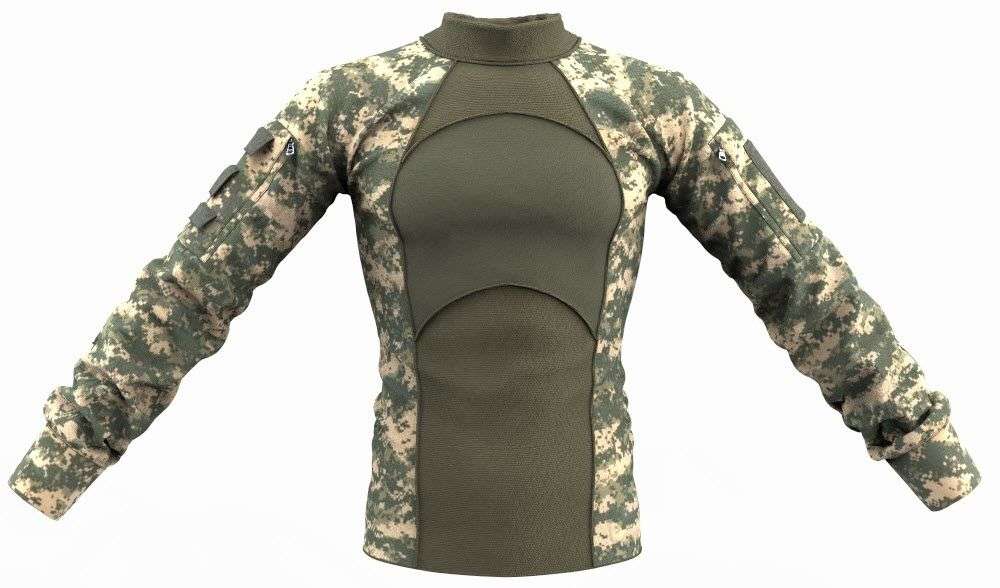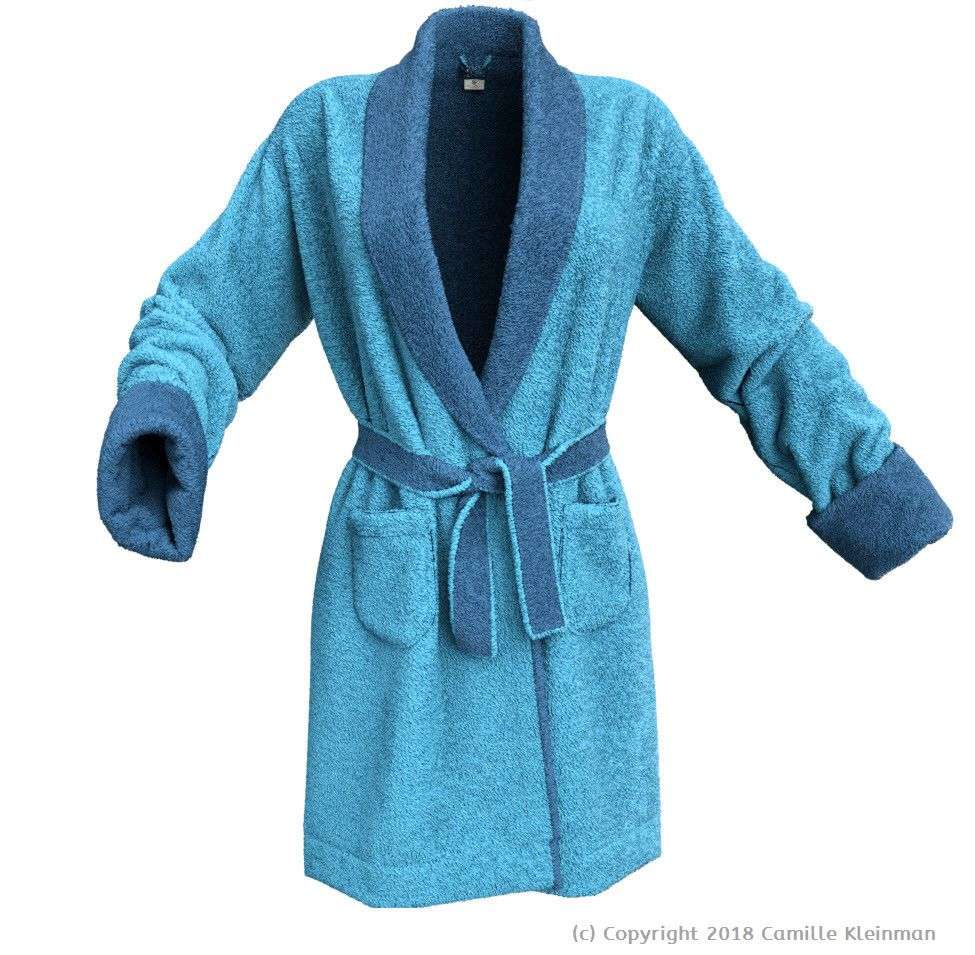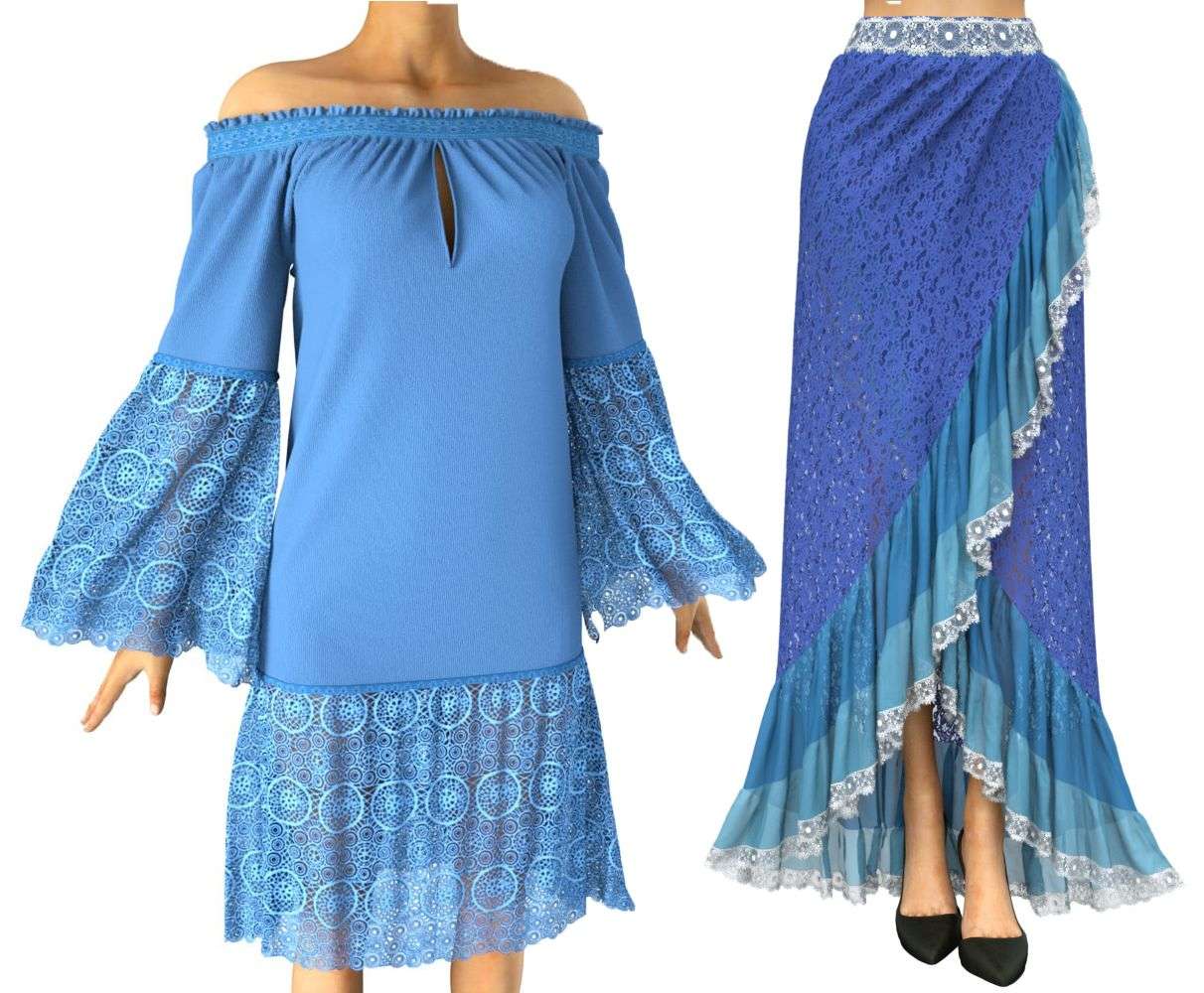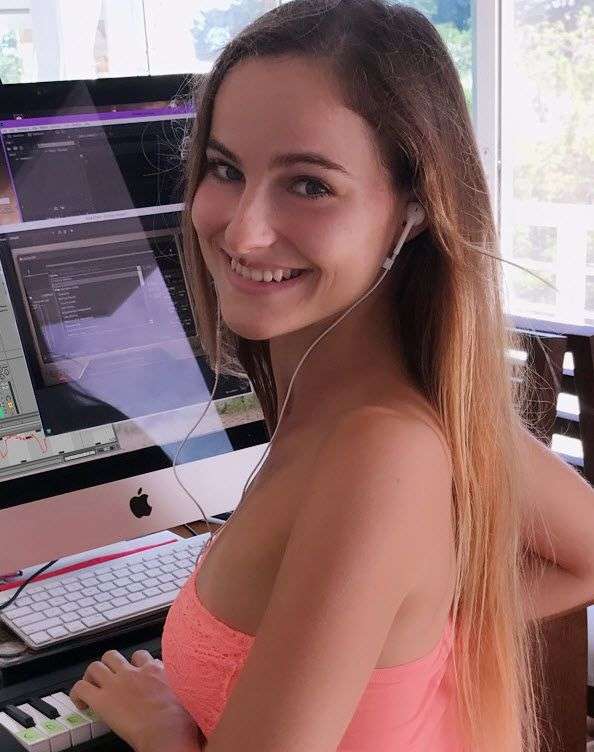
What kind of 3D work do you do?
I specialize in creating realistic, dynamic 3D clothing in Marvelous Designer and teaching others how to use the program and create clothes.
As the Co-Founder of CG Elves, I created the first and highly-acclaimed online training program for Marvelous Designer.
Over 30,000 artists as well as top studios have learned MD with my training.
Our clients include EA, Saatchi & Saatchi, Squeeze, Oculus, Crystal Dynamics, Virgin Media, Kite & Lightning, Hi-Rez Studios, a Warner Bros game studio, Rocksteady, and more.
What is Marvelous Designer and who uses it?
Marvelous Designer is a popular 3D software used by many artists to create dynamic 3D clothing for video games, 3D art, DAZ/Poser, iClone, 3D animations, VR experiences, digital doubles in films and more.
MD is used by big game studios, production companies etc.
The program is also used by virtual fashion designers who design 3D clothing for virtual clothing catalogues (especially sports clothing). For real-world clothing, usually fashion designers use CLO3D since it has a few more tools than MD for real-world sewing such as seam line allowances, tapping etc.
However, since CLO3D is much more expensive than MD, some fashion designers use MD instead, especially for quickly designing clothes and visualizing how they would hang and move and look etc.
Marvelous Designer is also used by DAZ/Poser/SecondLife/Sansar/Renderosity creators who make 3D clothing for sale in these marketplaces. We’ve also had a book publishing company and cover artists buy our MD training to create clothing for 3D characters used on book covers.
Also, some architects use MD to create pillows, bed covers, towels, curtains, or clothing to hang in their closets.
Occasionally, I’m surprised by some very unique clients who use MD. Such as a law firm who uses MD to create clothing for 3D crime scene visualization/crime scene reconstruction.
It’s a pretty awesome program with which you can create realistic 3D clothing much easier and faster than 3D sculpting/modeling once you know how to use MD.

How did you get into 3D?
By accident actually! I love writing stories and have many ideas for comic books, however, I don’t yet have the skills to create illustrations for my books.
One day, I stumbled upon DAZ studio and thought that would be a great way to create the illustrations. The problem was, the clothes they had back then looked horrible. Like plastic goo. Without a single wrinkle. It was appalling.
After a lot of researching online for a solution to make realistic clothing, I found Marvelous Designer.
The problem was, there were NO tutorials how to use it, and I didn’t have a clue about sewing.
How long have you been working with Marvelous Designer?
For a long time. I started using Marvelous Designer back when no one in the 3D industry had heard of it. At that time, there were no tutorials and no courses available. Even the official MD documentation was very simple and lacking.
Back then, I was 18 YO and had absolutely no knowledge about sewing or pattern making. The only thing I’d ever sewn in real life was a pair of doll pants (as a kid) and they came out bad I burst out crying.
It took me months to figure out all the ins and outs of how to make all the clothes I wanted in Marvelous Designer. Different kinds of sewing methods, pleating, all types of sleeves, padding effects, gathers, cutting and shaping patterns... after many late nights (and endless clothing blowing up in my face because of some mistake in the sewing), at last, I mastered it.
At first, I had no connections in the industry at all. (I didn’t know anyone. I hadn’t gone to an art school, in fact, I haven’t even finished high school!)
Surprisingly, after I posted my first 3D clothing on my Facebook, somehow or another 3D artists found me and started sending me friend requests.
Everyone was blown away by my 3D clothing and kept asking me “wow, how did you do those wrinkles?!”
Then when I told them about Marvelous Designer, they begged me to make tutorials and waited patiently for months while I recorded and edited them.
And that’s how CG Elves was born.

How did you promote your courses online?
In the beginning, my first students were my Facebook friends who had been patiently waiting for me to finish the training for months. When they saw the high quality of my courses, they recommended me to their friends who told their friends and so forth.
After that, I promoted CG Elves online using various SEO tactics.
Asides from SEO, I also networked a lot on LinkedIn sending requests to all sorts of people in the industry and reaching out to decision makers at studios and production companies to interest them in my products and training. Since I was a young kid, I’ve always loved sales and marketing, so it didn’t scare me to contact strangers.
Lastly, I also contacted CEOs of various companies, big websites, magazines, and persuaded several to become our partners and promote my training to their members. Some of our partners include Reallusion (makers of iClone), SecondLife/Sansar, CG Trader, and Future plc (the company which publishes 3D World magazine), and others.
Where did you learn about SEO and online marketing?
At age 12, I learned a lot about SEO from my mother who is an online marketing expert and webmaster.
When my mom and I came to the Caribbean she gave me an option. Go to a boring local school or drop out of school and learn useful skills instead. I chose to leave school and so she taught me SEO and online marketing instead.
Back then as a kid, sometimes I regretted the choice. School would have been less work. Sometimes, I worked 10 hours per day on the computer, with hardly a break, including weekends. But in the end, it was worth it.
Which marketing tactics did you use?
Content marketing mainly. Writing articles and free 'how to' tutorials. Uploading pictures and videos of my clothes everywhere possible. That and making free Marvelous Designer tutorials on YouTube.
I also made free 3D models which I promoted in various Facebook groups and forums.
Additionally, I got some press releases published on news websites like ABC6, Wallstreet Select, Academia, AZ Central (part of the USA Today network), Daily Herald, ABC 7, NBC Right Now, WallStreet Select, International Business Times etc.
Though honestly, the free Youtube tutorials brought much better results than the press releases.
What were the main challenges you faced making the Marvelous Designer course?
I’m a bit of a perfectionist (I learned that from my mother). She always taught me to only make excellent products and never sell anything less. Even the muffins which I sold as a child were the best in the city.
So, when I was making the Marvelous Designer video tutorials, I worked hard to make them perfect. I spent way too many hours editing out every smallest cough/sniffle/sneeze and speeding up parts of the videos where the cloth simulation was slow so as not to bore viewers and waste their time.
In addition, I also worked cleaning the audio from faint background noise and my breathing so it would be clear and pleasant for people to listen to.
The second challenge was retaining good rankings to be found in Google. Google’s algorithm keeps changing and one has to keep adding new SEO content to maintain rankings in Google.
Was it worth the effort? Would you do it again?
Absolutely! The best part of getting into 3D was the amazing people I met and befriended.
I’m so grateful to know them, they are really wonderful guys and great friends.
Maybe it’s something about this industry, but I never met so many nice people before.
Even if it wouldn’t have been worth it financially, I would have still done it.
Every time a student thanks me or tells me how awesome my course is and how much it helped them, it makes me soooo happy. It’s a really wonderful feeling to make people happy and be able to help them in their careers.
Recently, one student from a poor country told me she just got her first job online as a designer because of my training. Made my day.
Asides from that, on the business sense, yes, I think it was worth it. It was successful from the first moment I launched it and the recurring income has been supporting us for several years now.

Which other tools asides from Marvelous Designer do you use?
Asides from MD I don’t really need to know many other tools. For rendering, I know to use Keyshot, Octane Render, and Marmoset Toolbag (love love love Toolbag! It rocks). As for texturing (I’m not a texture artist) I just create seamless textures from images of real cloth fabrics.
Asides from those tools, I use Camtasia, Premier Pro, and Audition to edit & record my tutorials and clean the audio.
Some years ago, I started to learn ZBrush and I was crazy for it! But then I got too busy with Marvelous Designer and didn’t have a chance to continue my ZBrush studies. One day soon I’ll get back to it!
It’s very useful to know Zbrush if you want to add special décor to your clothing (model a special belt buckle or buttons) or to sculpt over the clothes and make special stitches etc.
As for texturing for clothing, I recommend Substance Painter.
What is a day in your life like?
Well, after the initial 1.5 years of hard work of making the course and promoting it online, I didn’t have to do too much more work for the CG Elves project. But it’s not like I retired!
I’m always busy, studying something or working hard on a new project.
After CG Elves, I started learning coding, building Messenger chatbots, and doing online marketing campaigns for products of other companies.
As for a regular day in my life – since I live on a Caribbean island it usually starts with mom and I going to the beach early in the morning, then having lunch and starting to work (often until late at night).
To relax before bed, I watch Netflix in Russian and Spanish (I’m still learning those languages).
Before my beloved dog died, I’d also take walks/jogs with him along the beach in the day time.
Do you think it’s better to work for clients or sell products online?
I think it’s good to do both!
Getting a job is very important and a great thing for artists.
It gives you awesome credentials, experience, and connections in the industry. (And a reliable income.)
Even if you want to sell products online, it’s useful to have a reliable wage/income so you don’t have to worry about making money.
It takes time to promote oneself online and in most cases, you won’t be seeing awesome income from day one.
Plus, having a job at a top studio gives you more credentials which will help you if you want to sell products online one day.
I personally am a strange case. Over the years, I got many job offers from top studios and fashion companies, but I never liked the idea of working 9-5 and having a boss. I don’t know why, but it really stresses me to think of working for someone.
So, each time a company would invite me to train their teams or make clothes for their movies or games, I’d instead recommend them to buy my training and presets. Which is really all they need to get their artists trained on Marvelous Designer.
But don’t take me as a good example!
What tips do you have for artists who want to sell products or courses online?
First and foremost, make awesome products. Really awesome ones.
If you’re currently a student with limited skills, wait until you have more experience and skills before making tutorials or products for sale.
I’ve bought so many tutorials from people that were absolutely terrible. Background noise so loud you can hardly hear the teacher or a shrieky microphone which gives you ear aches. A bad teacher who doesn’t know what he’s teaching and wastes hours going around in circles with “oh no, actually, that’s now how it’s done”.
If you make a tutorial, make it about something you really, really know well and can teach others. Something which others will be glad they bought and will happily recommend to their friends.
Word of mouth is a great form of free marketing.
When you make a great product whether it’s a preset, 3D model, or tutorial, people will be happy, share it, and come back to buy more from you.
If you make crappy products for sale, people will talk. You’ll get a bad reputation and very soon no one will buy from you.
Always give a lot more value back to people than the money you take.
Alright, so after making a great product, find places where you can sell it. Gumroad. Cubebrush. Artstation marketplace. etc.
Many artists I know sell products without a website, just on Gumroad. Because my mother is a web developer, she built the CG Elves website so we sold the products from there. However, you really don’t need a website to start off (and maybe never).
It’s easy to get started selling online. A friend of mine recorded a tutorial within 1.5 hours, (without even editing it) and then uploaded it for sale on Gumroad. He posted about it on his personal Facebook page and made over $1,000 the first day already with hardly any work involved.

What is the best way to promote yourself?
One of the best ways to promote yourself if you don’t yet have a good reputation and followers, is with freebies. Even a few, small free products or free tutorials.
If you want to sell courses, making free tutorials is a great way to gain trust. People can first watch your free tutorials and if they see that you’re a good teacher and like you, they’ll more happily buy your paid courses.
It happened with me too. At first, no one knew of me and CG Elves. There were many who were hesitant to buy, afraid it would be a waste of money. After I made a couple of free tutorials, and people saw how well I taught, they felt more confident to buy the course.
It’s also always easier to promote freebies online than paid products. Posting in forums etc. about your paid courses might be seen by some forum moderators or members as annoying advertising.
Where and how can you promote your work?
Spend ab it of time researching online. Make a list of all the places online (such as forums and websites) where you can promote your freebie or product. If you’re a VFX artist, look for VFX and software forums, Facebook groups, and blogs which write about VFX.
Contact writers at VFX websites/blogs and tell them about your awesome (freebie or product). Persuade them why it’s great and they should tell their readers about it. Offer them a special coupon for their readers or a unique freebie only for the readers of their website.
Do the same with group owners (Facebook groups, Linkedin groups) and contact the admins of forums. If you can’t contact the admins, simply post in relevant forums about your freebie (they usually won’t be happy if you post about your paid product but freebies are fine to share and promote).
How to get people to spread the word about your products?
Make a Facebook page and invite your friends. Share freebies on your page. Ask them to share it with their friends.
If you have great stuff, people will happily share it with their friends. I’ve had happy students share my training all over, Linkedin, Twitter, FB, forums – without me even asking them to.
Start a Youtube channel with free tuts. Grow a following.
Post images of your work on Pinterest, Instagram, and all the art portfolio websites like Behance.net, Artstation of course, CGSociety, DeviantArt, Renderosity galleries, Sansar, DAZ galleries, and any other places you find.
Eventually all this work will pay off when people start to find you online and either hire you or buy your products.
Which portfolio sites are the most important for artists?
In my opinion having accounts on Linkedin, Artstation, and Behance is very important whether you want to be hired or sell products.
Many artists don’t have a Behance. It’s a great place to post your work since it ranks very high in Google and if you optimize the titles and descriptions of your artworks, you can get found when people search Google.
I’ve gotten quite a few companies contacting me for big projects through Behance.
(Tip: Make sure your Behance account settings are set to send you email notifications about new messages or you might miss out on some jobs! I did at first.)
Also, join Linkedin groups and post your work there. Network like crazy!
Just by adding people to my network, without actively looking for work, I’ve had some of the biggest fashion companies, online clothing shops, and studios contact me on Linkedin for work.
You can also write articles on Linkedin about your freebies and products. Medium is also a great place to write articles to promote your products.

What is the best way for artists to quickly learn Marvelous Designer?
Become a seamstress... just kidding! :P
Some guys get scared when they hear the words “sewing” and “patterns”.
The truth is, you don’t need any formal education (like fashion school) or any knowledge of sewing to create clothing in MD (even with those scary seam lines).
Of course, having some basic sewing knowledge might help you, but it’s not needed.
All you need is to learn how to use Marvelous Designer tools and how to create all the different kinds of basic clothing. Once you know the basics, you can go crazy and create every type of fantasy outfit you want.
Almost every one of my students had no clue how to sew and had never touched a sewing machine in their lives. Some of them mastered Marvelous Designer watching my tutorial for just one week and went on to get hired and create even more amazing clothes than I ever did!
How does one create clothing in Marvelous Designer?
Just like in the real world, every clothing item in Marvelous Designer is made of different shaped patterns which are sewn together and simulated.
In order to create 3D clothes in MD, you need to understand the fundamentals of how to design the patterns, sew them properly together, and create the right fabric settings to give the clothes a believable hang and a realistic look (in simulations and animations).
Every clothing pattern, whether it’s a shirt, sleeves, pants, a dress, or a skirt, is designed based on one of the basic kinds of clothing patterns.
There are several main types of patterns for different kinds of clothes. For instance there are over 12 kinds of sleeves; puffy sleeves, raglan sleeves, dolman sleeves, angel sleeves, open-shoulder sleeves, etc etc etc.
When you know the basic patterns, you can change them, make them wider, longer, add more fabric or less fabric, add special gathers etc. to create the exact look you want.
It all starts with a basic pattern.

How did you learn to create clothes in Marvelous Designer without any courses?
Lots and lots of trial and error and practice. In total, I spent 1 year full time, 6 days a week, often into the night, figuring out how to create all kinds of clothes, from all the common kinds of sleeves to all the types of skirts, shirts, collars, pants, jackets, capes, cloaks, hoods, suits, dresses etc.
What does your course cover?
The training program is over 52 hours long, covering everything I know and teaching step-by-step how to create all kinds of clothes from scratch.
Even total beginners, who have no sewing knowledge and never used Marvelous Designer before, can in a very short time create great looking clothes by following my tutorials. One of my students created his first zombie outfit in under a week!
The training starts with an in-depth beginners’ course that covers the functions and tools in the Marvelous Designer software, as well as all the do's and don'ts.
Once students know how to use the software properly, they will learn in the intermediate and advanced workshops how to create a great variety of clothes.
Students will learn how to make different shirts for women and men, as well as all sorts of collars, cuffs, zippers, buttons, pockets, many kinds of sleeves, several jackets, techniques to make quilting and stuffed puffed effects, capes and cloaks, hoods and hats, a 3 piece suit with a vest and 3 kinds of suit collars, military cargo pants, a military combat shirt and an officer's uniform, many kinds of skirts and dresses, ribbons and a corset with fake hooks and strings. They'll also learn how to make gathered effects, as well as box pleats, accordion pleats, knife pleats and sunburst pleats. And a lot more!
Asides from the training, I also sell a huge library of ready-to-use Marvelous Designer garment files, clothing presets, and realistic seamless fabric textures for texturing clothes.
To learn more about the Marvelous Designer courses or our huge Marvelous Garment library, visit CGElves.com

Did you receive any feedback from your students?
Lots! :) Here is what some of my students have to say:
"Mastering marvelous designer is an excellent course that guides you step by step in learning one of the key software’s in any character modeling pipeline when it comes to the creation of realistic clothing.
Starting from the basics of the software, the course gradually introduces you through detailed video tutorials to the creation of piece of clothing of increasing complexity, in particular the workshop tutorials and theme exercises are extremely useful to anybody who wants to achieve realistic looking clothing and garments." – Alessandro Baldasseroni, Character Artist at Riot Games. www.eklettica.com
"CG Elves has the most extensive tutorials on Marvelous Designer that I`ve ever seen! The quality of the courses are amazing.
I definitely recommend this for anyone trying to learn Marvelous and the art of Cloth making, especially if you’re in the game industry like myself." – Glauco Longhi, Character Artist at Naughty Dog, www.glaucolonghi.com
“CG Elves contains some of the best training I’ve seen. Short, straight forward tutorials that focus on tasks we need to master as artists. It doesn’t get much better than this training for Marvelous Designer.” – Ryan Kingslien. First product manager of ZBrush, founder of ZBrushWorkshops and UArtsy, Certified ZBrush Instructor.
“First one that I found to be interesting and worth watching. Great course! I Already could (create clothes in MD) but I did pick up some tricks and saw some great workflows…
Doesn’t matter if you’re a beginner or a advanced user of MD, CG Elves got you covered! Definitely my go to place when it comes to picking up tricks and leveling up my MD knowledge.”
– Hasan Bajramovic, Character Artist for Blur Studios, Digic Pictures, Axis Animation and more.
"That’s really what I was looking for. I knew (MD) a tiny bit before, but I was mad each time I used it, nothing were working etc., it was so frustrating. By following the course, I was able to quickly create believable cloths for my characters (within 1st week). Highly recommended for artists!"
– Arthur Gatineau, Character Artist. www.arthurgatineau.com
“I believe that Camille tutorials are the most extensive Marvelous Designer tutorials ever made, she covers everything in the application literally, and her teaching way is extremely simple.
I would recommend her tutorials for all 3D character artists, they are the best online!”
– Eyad Hussein, Character Technical Director at Sony Pictures Imageworks.

What skills seem to be missing all too often?
Anyone who puts in enough time and effort can become really good at whatever they do. So the best way to get the skills you need is to learn from everyone you can, free tutorials, paid courses, and practice, practice, practice!
Describe a project brief that you’d recommend artists create for their portfolio
For Marvelous Designer, I think the most important thing is to show that you can create many types of clothing. Not just 1 or two simple dresses. But all sorts of shirts and pants and clothes. Fantasy clothes. Everyday clothing. Military clothes. etc. A variety of different garments to show your abilities.
When looking for 3D artists who knew MD whom I could send extra work to, some people applied with a very poorly portfolio with just a render of the default MD dress which comes for free with the program or one baggy shirt which anyone could make. Not impressive.
(And a few even applied with renders of my own clothes!)
If you’re going to apply to jobs and claim to know how to create 3D clothes, don’t just steal/use someone else’s garments and say you did it. It won’t help, because even if you get the job based on a pretty render of someone else’s clothes, you won’t be able to keep the job for long.
So, the short of it, learn to be really good at whatever you do, show your best works (and as many as possible) and then you’ll get work.
What mistakes do you see artists making when applying for jobs
Oh boy... there’s no short answer for this one.
Along with my mom, I’ve hired, supervised, and interviewed 100s of people in various industries since I was 17.
Common mistakes I’ve seen:
- Rude or angry people. At least try to be polite when applying to a job and if you don’t immediately hear back from the employer, don’t bombard them with angry follow up emails. Maybe they just didn’t manage to get to your application yet!
- People who feel very privileged and make it clear that they’ll accept the wage but don’t want to work. Some applications were as short as: “okay, you can pay me” with no other info at all!
- People who present themselves poorly.
- Poor portfolios with hardly any examples. Some people apply without a portfolio, and when one requests their portfolio or some info about their work experience, they say “I don’t have a portfolio but I can do it!”. It’s like saying, I don’t have a medical degree but trust me, I’m a great surgeon so hire me please.
- Unbelievable high wage expectations. Sure, there’s nothing wrong with wanting to earn a good wage, but asking for something that’s 5x or 10x the average wage isn’t realistic.
- Misspelling the HR person’s name multiple times. (Doesn’t look good. Makes one wonder how good that person’s attention to detail will be when he works on a job.)
My advice:
- Always be friendly and polite. Include a greeting in your email. Make sure (double check it necessary) that you correctly spelled the person’s name whom you’re talking with.
- Sign your name at the end of the email. Sometimes, I didn’t know how to address an applicant who didn’t mention his name anywhere and had an email address with some fantasy creature’s name.
- Use a spellchecker or the free Grammarly browser extension. It looks bad to send a job application full of unnecessary typos. Sure, not everyone has perfect English and that’s fine, but it only takes a second to correct typos using a spell checker.
- Prepare a great portfolio before applying to a job.
For more career and job application advice, I recommend to check out Allan McKay’s podcasts. He has many great free ones with tips how to get hired. https://www.allanmckay.com/podcast-list-page/
And of course, once you get hired, always do your best, be honest, and don’t try to cheat your employer by playing games on your phone or hanging out on Facebook all day long during work time.
If you could give one piece of advice to artists starting out, what would it be?
Learn as much as you can, practice a lot, and network. Avoid wasting time on social unless it’s for a good reason like networking or growing a following. If you count all the hours you spend on social each day, you’ll probably be surprised how many tens of hours it adds up to each month. Hours which you could use to improve your skills and get a job faster!

Bio
Camille Kleinman is a leading Marvelous Designer trainer, Co-Founder of CGElves.com, artist, screenwriter, online marketer, and a dog lover.
She’s also a contributor at Today.com, Wikipedia, BuzzFeed, Kinja, Intuit, and has written articles published on Associated Content (a Yahoo! News partner), eHow, WikiHow, Academia, Instructables, as well as press releases published on news websites such as ABC6, Daily Herald, Wallstreet Select, Silicon Investor, Fox 14, and many more.
Camille loves writing, macro photography, extreme sports, fantasy, horror, and animals.
Links:
https://CGElves.com/
https://www.facebook.com/CGelvesOfficial/
https://www.instagram.com/camillekleinman/

